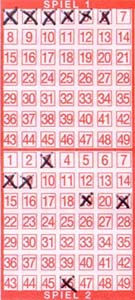Exercise 2.4: Number Lottery (6 from 49)
For the "number lotto" the following conditions should apply:
- Six winning numbers are drawn from the $49$ numbers (balls) in a drum ("6 out of 49"),
- then as the seventh ball the so-called "additional number" (German: "Zusatzzahl") ⇒ $(Z)$.
Independently of this, a "super number" $S \in \{0, \ 1,\hspace{0.1cm} \text{...} \hspace{0.1cm}, \ 9\}$ is selected at random. If this number matches the final digit of the lottery ticket, the main prize is increased decisively.
In this exercise, the following winning classes are considered:
- 6 correct numbers with "super number" ⇒ $\text{"6R + S"}$,
- 6 correct numbers without "super number" ⇒ $\text{"6R"}$,
- 5 correct numbers with "additional number" ⇒ $\text{"5R + Z"}$,
- 5 correct numbers without "additional number" ⇒ $\text{"5R – Z"}$,
- 4 correct numbers ⇒ $\text{"4R"}$,
- 3 correct numbers ⇒ $\text{"3R"}$.
For subtasks (1) to (6), start from the upper lottery ticket: The player has ticked the numbers "1" to "6" here.
Hints:
- The exercise belongs to the chapter Binomial Distribution.
- This exercise was designed around 2002. It is possible that the rules of the (German) lottery have been changed in the meantime.
Questions
Solution
- $$\text{Pr("6R")}={\rm \Pr}(123456\ \cup 123465\cup \ \text{...} \ \ \cup 654321).$$
- This takes into account that the order does not matter in the drawing.
- In total, there are exactly $6! = 1 · 2 · 3 · 4 · 5 · 6$ equally probable permutations for the set of numbers:
- $$\text{Pr("6R")}=6!\cdot \rm Pr(123456).$$
- The probability of the number "1" being drawn as the first ball is $1/49$. The probability of "2" being drawn as the second ball is correspondingly $1/48$ (since there is now one less ball in the drum). Thus one receives as final result:
- $$\rm Pr(123456)=\frac{1}{49}\cdot\frac{1}{48}\cdot \frac{1}{47} \cdot \frac{1}{46}\cdot \frac{1}{45} \cdot \frac{1}{44},$$
- $$\text{Pr("6R")}=\frac{1\cdot 2\cdot 3 \cdot 4 \cdot 5 \cdot 6}{49\cdot 48 \cdot 47 \cdot 46 \cdot 45 \cdot 44}.$$
- This is exactly the inverse of "49 over 6". It follows that:
- $$\text{Pr("6R")}=\left({49 \atop {6}}\right)^{-1}=13\hspace{0.08cm}983\hspace{0.08cm}816^{-1}\hspace{0.15cm} \underline{\approx71.5\cdot 10^{-9}}.$$
(2) The probability that the final digit of a lottery ticket matches the super number is $10\%$.
- But since the drawing of the super number is independent of the normal drawing, we now get for the probability we are looking for
- $$\text{ Pr("6R + S")} \hspace{0.15cm}\underline{\approx \ 7.15\cdot 10^{-9}}.$$
(3) In what follows, $Z$ stands for "additional number". Then holds:
- $$\text{ Pr("5R + Z")}={\rm Pr(12345} Z \ \cup \ {\rm 1234} Z\rm 6\cup \ \text{...} \ \cup \ Z {\rm 23456)}.$$
- There are six permutations here. The probability for $\rm 12345Z$ is the same as for $123456$. It follows with the result of subtask (1):
- $$\text{ Pr("5R + Z")}=6\cdot\left({49 \atop {6}}\right)^{-1}\hspace{0.15cm} \underline{=0.429\cdot10^{-6}}.$$
(4) If we denote by $X$ a drawn number that is not one of those checked, we can write for the probability we are looking for:
- $${\rm \text{ Pr("5R")}=Pr(12345} X \ \cup \ {\rm 1234} X6\ \cup \ \text{...} \ \cup \ X23456).$$
- There are six different possibilities for the location of $X$ , all of which are equally probable. It follows that:
- $$\rm \text{ Pr("5R")}=6\cdot Pr(12345\it X\rm ).$$
- Here $X$ can stand for any of the numbers $7$ to $49$, which again are all equally probable.
- Thus, with $\rm Pr(123457) = Pr(123456)$, the result of subtask (1), we get:
- $$\rm \text{ Pr("5R")}=6\cdot 43\cdot\left({49 \atop {6}}\right)^{-1}=1.85\cdot10^{-5}.$$
- To subtract is still the case that also the additional number was drawn correctly. Therefore:
- $$\rm \text{ Pr("5R – Z")}\approx 18.5\cdot 10^{-6}-0.429\cdot 10^{-6}\hspace{0.15cm} \underline{\approx 18.1\cdot 10^{-6}}.$$
(5) After some considerations, we arrive at the result:
- $$\rm Pr(\it k\hspace{0.15cm} \rm correct\hspace{0.1cm}numbers)=\left({\it m \atop {\it k}}\right)\cdot\left({\it n-m \atop {m-\it k}}\right)\cdot\left({\it n \atop {m}}\right)^{-1}.$$
- The last term in this equation gives the probability for a very specific "$m$ out of $n$" combination.
- The first term describes the number of permutations that numbers drawn from $m$ are exactly $k$ correct. For $m = 6$ and $k= 5$ this gives the factor $6$.
- The middle factor gives the number of possibilities that all remaining drawn numbers $($thus $m-k)$ is one of the unfavorable numbers $($for this there are $n-m)$ . For $m = 6$ and $k= 5$ this term gives the value $43$ according to point (4) .
- As a special case we get for the "6 out of 49" with $k= 4$:
- $$\rm \text{ Pr("4R")}=\left({6 \atop {4}}\right)\cdot\left({43 \atop {2}}\right)\cdot\left({49 \atop {6}}\right)^{-1}\hspace{0.15cm} \underline{=0.969\cdot10^{-3}}.$$
(6) According to the general formula calculated in (5), it further holds:
- $$\rm \text{ Pr("3R")}=\left({6 \atop {3}}\right)\cdot\left({43 \atop {3}}\right)\cdot\left({49 \atop {6}}\right)^{-1}\hspace{0.15cm} \underline{=18.1\cdot10^{-3}}.$$
(7) Both statements are correct:
- The probabilities are equal, of course. Because many people know this and want to demonstrate their knowledge (at least to themselves) many more people play this combination than a rather unspectacular one.
- However, since the amount to be paid out in a winning class is determined in advance and this win then has to be divided by a larger number of winners, there is of course less left for the individual.
- On the other hand, since many lottery players bet on their date of birth, the combination chosen here is not so favorable either. The numbers "3", "8" and "9" can indicate both the day and the month and, moreover, almost all players' year of birth starts with "19".
